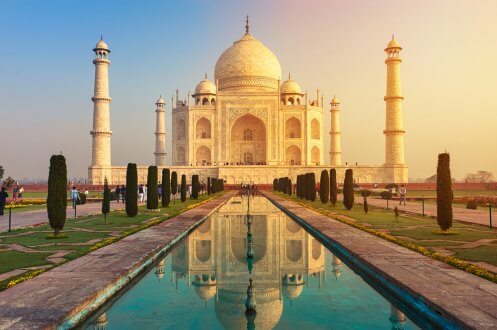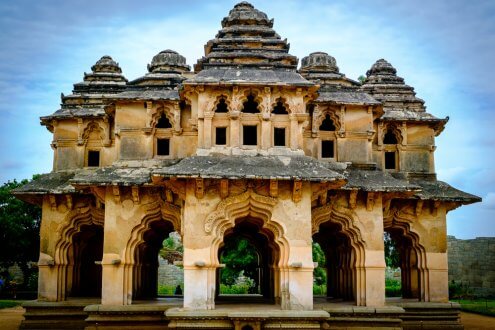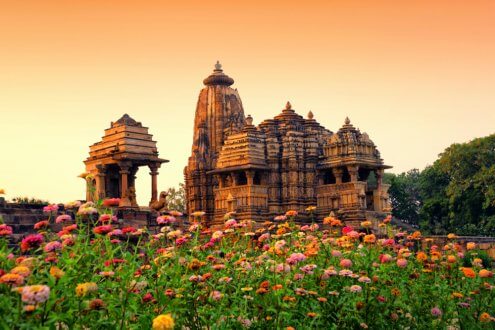UNESCO World Heritage Sites in India
Table of Contents

UNESCO World Heritage Site is selected carefully, based on the special cultural and historical significance attached to the site. The motive behind it is to encourage a country or a state to identify, protect and conserve its cultural heritage. Every country boasts of a number of UNESCO World Heritage sites, and India too boasts of a number of them.
UNESCO World Heritage Sites in India are selected carefully, and the selection is based on specific criteria. The site or structure should be a work of creative brilliance by humans and should be an important centre encouraging the exchange of human values. The site should depict minimum one significant evidence associated with a cultural tradition that may soon get vanished. Moreover, it should be an outstanding example of architecture, artistic and literary works that are of immense universal importance.
Some of the UNESCO World Heritage Sites in India are:
Taj Mahal, Agra

Well-famed as one of the Seven Wonders of the World, the Taj Mahal was built by Emperor Shah Jahan at the bank of river Jamuna and in the loving memory of his wife, Mumtaj Mahal. Built in 1653, it is an excellent example of Mughal architecture and one of the most recognised monuments across the world.
Hampi, Karnataka

Hampi lies within the ruins of the ancient kingdom of Vijayanagar and is a collection of heritage sites that display the Dravidian style of art and architecture. Virupaksha Temple, an important religious centre for the Hindus, holds the most significance. There are several other temples and monuments at Hampi complex.
The Ellora Caves, Aurangabad

Well-famed for their Indian-rock cut architecture, the Ellora Caves date back to about 600 to 1000 AD. These caves hold great significance as they play a crucial role in understanding the lives of the people of those times. As one can see Hindu, Buddhist and Jain temples located side by side, they point to the higher level of tolerance towards each other and various faiths and beliefs in ancient India.
Sun Temple, Konark

The 13th-century Sun Temple is situated in Konark and was built around AD 1250 by King Narasimhadeva. What is unique about the temple is that it is shaped like a massive chariot with a stone wheel, pillars, and walls. Six enormous horses lead the chariot. The Sun temple is looked upon to be the largest Brahmin sanctuaries in India and reflects the splendour of the traditional Kalinga architectural style.
Sanchi, Madhya Pradesh

Sanchi boasts of the Buddhist monuments, which are known to be the oldest stone structures in India. Emperor Ashoka commissioned the making of those structures in 3rd century BC. It is easy to recognise the hemispherical brick structure of the Sanchi Stupa that is based on the relics of Buddha. There are many other structures in Sanchi that hold cultural and historical significance like pillars, temples, monasteries, and palaces.
Kaziranga Wildlife Sanctuary, Assam

Kaziranga Wildlife Sanctuary is world famous for its one horn rhinoceroses and is located in the untouched rural areas of Assam. The park is located within the floodplains of the river Brahmaputra and comprises of thick grasslands. Rhino is the most endangered of all the Indian faunal species. Other animal species that one can spot in the park include swamp deer, hog deer, water buffalo, gaur, dolphin, otter, wild boar, and more.
Khajuraho, Madhya Pradesh

Another important UNESCO World Heritage site in India Khajuraho is well-known for those erotic figures and sculptures depicted in Nagara style symbolism. Those stone carvings of human and animals have been aesthetically depicted and represent the rich cultural heritage of India. Most of these monuments and carvings were made around 950 to 1050 CE during the Chandella dynasty.
Ajanta caves, Maharashtra

The ancient Ajanta caves date back to around the 2nd century. The caves are the most beautiful masterpieces of Buddhist caves that were rock cut and boast of spectacular paintings and sculpture. The Ajanta caves were built in two phases, first under the Satavahana Period and second during the Vakataka Period. These caves are a fine example of progressive Indian art and architecture.
Bodh Gaya, Bihar

Bodh Gaya is an important religious centre and is located near Patna. The site holds great significance for the Buddhists as it is believed to be the place where Gautam Buddha achieved enlightenment under the holy Bodhi Tree. It was during the reign of Ashoka the Great that the famous Mahabodhi Temple was made. This is why Bodh Gaya is the holiest pilgrimage spot for the Buddhists.
Red Fort, Delhi

Emperor Shah Jahan built the Red Fort in New Delhi when he made it his capital. During his time, Delhi was known as Shahjahanabad, and soon the Red Fort became a political hub of the Mughals. It is an excellent example of Mughal art and architecture. However, one can see influences of Timurid, Hindu and Persian styles along with Indo-Islamic styles on the fort. The Red Fort is made of red sandstone and lodges several other structures like Diwan-i-khas, Diwan-i-aam, and private pavilions.
See More : 9 Activities to Relive Royalty in India
Chola Temples, Tamil Nadu

Chola Temples are a collection of different temples that were built during the Chola empire rule. The most important of all of these temples include Temple at Gangaikonda Cholapuram, Brihadisvara Temple, and the Airavatesvara Temple. These temples and their architectural style reflect the splendour and beauty of the Chola art and sculpture. People still carry out the rituals and festivities that were held at these temples thousands of years ago.
Sunderban National Park, West Bengal

The Sunderban National Park, located in West Bengal, is world famous for the Royal Bengal Tigers. The Tiger reserve is situated on the Sunderban Deltas and is one of the largest reserves in India. It is thickly covered by Mangrove forests and is home to the seriously endangered Bengal Tiger. One can spot other species too in the Sunderban National Park like spotted deer, wild boar, genetic dolphin, and other mammals. Another attraction of this reserve is the saltwater crocodile.
The list of UNESCO sites given here are worth-visiting so do plan to visit them whenever you get a chance.



